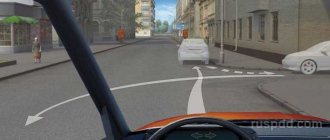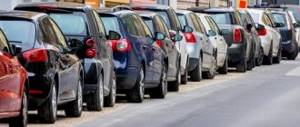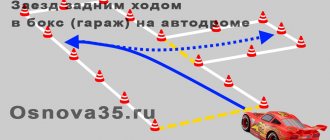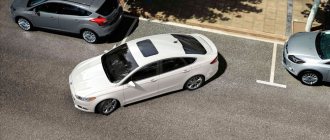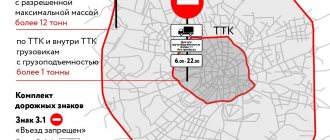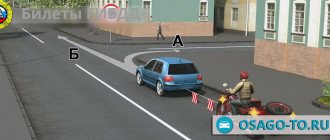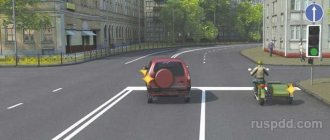Good afternoon, dear reader.
It has been repeatedly mentioned on the pages of the site that reversing is the most dangerous maneuver for the driver. However, the traffic rules do not pay too much attention to this maneuver, so many drivers do not know how to drive in reverse correctly.
In turn, violating the rules when driving in the opposite direction often leads to fines or accidents, the most common of which are hitting a pedestrian and colliding with a car. It is these types of road traffic accidents that are most often used by scammers to organize car scams.
Rules for driving in reverse
Let's consider paragraph 8.12 of the 2021 traffic rules:
8.12. Reversing a vehicle is permitted provided that this maneuver is safe and does not interfere with other road users. If necessary, the driver must seek the help of others.
So, reversing is allowed only if it does not interfere with other cars, motorcycles, pedestrians and other road users.
A very simple conclusion can be drawn from this point. If, while driving in reverse, the car was involved in a traffic accident, then the culprit of the accident is the driver who violated the requirements of paragraph 8.12.
Naturally, in the event of a collision, you do not need to immediately give up. Try to find violations in the actions of the other driver.
For example, he may exceed the set speed.
However, the violation of the second participant does not relieve responsibility from the driver who was driving backwards.
In the event of a difficult traffic situation, paragraph 8.12 suggests using the help of other persons , which can be both car passengers and pedestrians passing by. However, no comments are provided regarding the use of assistance from other persons.
In practice, you can ask the pedestrian to make sure that when reversing the car does not hit other cars or other obstacles. In addition, your assistant can signal to approaching cars and they will not interfere with the completion of the maneuver.
However, keep in mind that seeking the assistance of others does not relieve the driver of the obligation not to interfere with other vehicles.
Prohibition signs when reversing
The rules define sections of roads on which reversing is prohibited. The ban was introduced to prevent emergency situations.
Reversing is prohibited when there is a No Entry sign.
List of road segments where reversing is not allowed: intersections; tunnels; pedestrian crossings; highways; railway crossings; stops; bridges, forks, overpasses. There is an increased risk of accidents in these areas. Both pedestrians and cars participate here.
It is prohibited to drive backwards if there is a “No Entry” sign. It means that cars are not allowed to enter a certain section of the road. The ban does not apply to route transport. The sign looks like a white brick on a red background.
The sign restricting the movement of cars is “No movement”. This means that you cannot move in any direction. It is not installed in one-way areas. The “No U-turn” sign notifies drivers that it is impossible to turn around in this area. Reversing under this sign is also prohibited.
Where is reversing prohibited in 2021?
Paragraphs 8.12 and 16.1 of the Traffic Regulations list situations in which reversing is prohibited:
- at intersections;
- at pedestrian crossings;
- in tunnels;
- on bridges, overpasses, overpasses and under them;
- at railway crossings;
- in places where visibility of the road in at least one direction is less than 100 m;
- in places where route vehicles stop;
- on highways.
In all of the above cases, moving in the opposite direction can create an emergency situation.
Please note that the maneuver is not prohibited on one-way roads, but it can only be performed until an intersection, tunnel, bridge or other structure from the list above appears in the vehicle’s path.
I recommend that you read the list of places where reversing is prohibited. It must be remembered.
Fines for violations of driving in reverse in 2021
There is no definition of the concept of “reversing” in the traffic rules, but there are clearly established fines for violations.
What are these fines?
- If you stop and start backing up in a place where such a maneuver is prohibited, you will be fined 500 rubles. Let's say, at the same intersection, bridge or zebra crossing.
- If you were driving in reverse on a highway, the amount of the fine increases 5 times - up to 2,500 rubles under Part 3 of Art. 12.11 Code of Administrative Offenses of the Russian Federation.
We also found out above that driving onto a one-way road under prohibitory sign 3.1 “Entry prohibited” is subject to a range of penalties – a fine of 5,000 rubles, or deprivation of the right to drive a vehicle. And this is the worst-case scenario that awaits the unconscious driver.
Is there a 50% discount?
Yes, if you are fined for driving in reverse in violation of traffic rules, the fine can be paid in half.
The corresponding benefit is enshrined in Part 1.3 of Art. 32.2 Code of Administrative Offenses of the Russian Federation. So, if you manage to make payment within 20 days from the date of receipt of the violation order, it does not matter whether from a camera or from the hands of a traffic police inspector. In this case, instead of 500 rubles, only 250 rubles are due.
The period for repaying the fine is 60 days from the date of its issuance. If you do not meet the deadline within 2 months, there will be a delay. The new fine will be twice as large. For example, if you don’t pay the same 500 rubles for driving in reverse, you will have to fork out another 1,000 rubles. The total amount to be paid will be 1,500 rubles.
Accident while driving backwards
Let's consider popular traffic accidents when reversing:
1. Parallel parking.
A collision can occur if the driver of a parking car is not confident in using the rear-view mirrors (for example, using only the right mirror instead of all three). Most often, an accident occurs between a car parallel parking (orange) and a car "propped" from behind (green). However, more exotic situations are also possible.
For example, the driver of a green car may become frightened by a parking car, quickly put it in reverse, and crash into a red car that is approaching from behind. Several years ago I had the opportunity to see a similar accident in practice, so the situation is not imaginary.
Please note that in the event of a collision between a green and red car, the driver performing parallel parking is not a participant in the accident and will not pay for repairs to the damaged cars. The driver of the green car will pay for the repairs.
2. Reversing in the parking lot of a supermarket or parking lot.
Similar accidents occur with enviable regularity near all large stores. The cause of the accident, as in the previous case, is the inattention of the driver of the orange car backing up.
Allowed reversing
Sometimes this option is more appropriate than the usual method of movement. But maneuver is permitted in strictly defined places and situations:
- where there is no intersection;
- if necessary, leave the yard or enter its territory;
- on sections of the road where a U-turn is allowed;
- in areas with poor visibility of the path, if the driver has the opportunity to use the help of other people while performing an action;
- if necessary, on a one-way road in compliance with certain rules.
In all cases, a prerequisite for the maneuver is the absence of other objects (cars, people, other obstacles) in the path of the vehicle. Before starting to drive in reverse, he must make sure that this method of movement is safe. And it has no right to interfere with pedestrians or other cars following their path. In the traffic rules, the requirements for the maneuver are reflected in paragraph 8.12:
Reversing a vehicle is permitted provided that this maneuver is safe and does not interfere with other road users. If necessary, the driver must seek the help of others.
Is the driver allowed to reverse in the absence of other road users?
| 1. | Allowed, but only up to the pedestrian crossing. |
| 2. | Forbidden. |
Reversing on roads marked with a one-way road sign is not prohibited. But since there is a pedestrian crossing on the path of travel, where reversing is prohibited, the driver can reverse on this section of the road only up to the pedestrian crossing.
When is it prohibited to return
No amount of precautions or driving experience will help you avoid problems if you drive in reverse where it is not allowed by the rules. The maneuver is prohibited:
- at intersections;
- near pedestrian crossings and directly on them;
- in tunnels;
- on a bridge, overpass, overpass;
- near and on a railway crossing;
- at public transport and minibus stops;
- on highways;
- where the road is visible for no more than 100 m, that is, with poor visibility.
The list of places where driving in reverse is not allowed is available in paragraphs 16.1 and 8.11 of the traffic rules. In essence, they supplement, expand and clarify section 8.12 of the Rules, which says:
Reversing a vehicle is permitted provided that this maneuver is safe and does not interfere with other road users. If necessary, the driver must seek the help of others. Reversing is prohibited at intersections and in places where turning around is prohibited in accordance with paragraph 8.11 of the Rules.
After all, carrying out a maneuver on any of the listed segments creates an emergency situation.
Where and when is reversing prohibited?
Driving a car in reverse is permitted in cases where it is not prohibited by traffic rules, but even in the case of permitted traffic, you should remember that it is always dangerous if you do not have the proper experience, skills, and knowledge of the rules of the road. Traffic rules allow driving and maneuvering a car in reverse only on permitted road sections, in conditions of 100% visibility of the road, at low speed and with a guarantee that your driving will not create an emergency situation and a threat to people’s lives (Traffic Regulations, 8.12).
The prohibition on driving a car in reverse is indicated in the traffic rules more specifically and categorically. It is strictly prohibited to use the vehicle in reverse:
- on multi-lane highways;
- at intersections and pedestrian crossings;
- at public transport stops;
- at railway crossings;
- on bridges, overpasses, in tunnels.
In addition, you cannot reverse on any road if visibility is less than 100 meters, on sections of the road where turning is prohibited, under the signs “No Entry”, “No Passing” (“brick”) and “No Driving”.
Important! Reversing a vehicle is not prohibited on one-way roads, but only in areas where there are no tunnels, bridges, intersections, overpasses or forks. In addition, on such a road the driver is obliged to warn other road users about his maneuver with signals, move at low speed and when there are no foreign objects.
When should you not drive in reverse?
At times, reversing is necessary, and this is not prohibited if the driver knows and follows the traffic rules. It is recommended to exercise caution when performing this maneuver to avoid harming anyone. If visibility is very limited, then it would be wise to use the help of another person to guide the process. Then the movement will not entail any consequences.
It is important to know in which places you cannot use reverse:
- At the crossroads.
- In the tunnel.
- At a pedestrian crossing.
- At railway crossings.
- For traveling on the motorway.
- At the bus stop.
- On a road where visibility is limited (less than 100 meters).
- On overpasses and bridges.
In addition, it should be noted that a car driving in reverse in a place where turning is prohibited may be fined. So drivers should remember this so that they do not have to be punished. As for one-way traffic, this maneuver is permitted on such roads. However, exactly until there is a bridge, intersection and other places where it is forbidden to drive in reverse.
Important! The maneuver is permitted provided that it does not interfere with other motorists. It is also important to ensure that it does not create a dangerous situation that could lead to an accident.
Obviously, you can’t drive backwards at an intersection, but in places where this is allowed, specific conditions must be observed. First of all, the driver must make sure that there are no foreign objects in the way. You can only drive at a minimum speed to minimize the likelihood of getting into an accident. If there are other cars driving on the road, then the motorist should not force them to slow down or change direction by their actions.
The essence of the violation
There is no separate article in the Code of Administrative Offenses that would prohibit reversing at an intersection. There is only a clause stipulating that you cannot move in the opposite direction in certain places.
Reversing
These are:
- tunnels;
- one-way roads;
- railway crossings;
- overpasses;
- pedestrian crossings;
- intersections;
- roadsides;
- highways;
- bus stops;
- bridges;
- sections of the road with poor visibility.
Important! Art. 12.14: It is prohibited to make a U-turn or move in reverse on terrain not intended for this purpose.
For disregarding this rule, the violator will be fined 500 rubles*. If this is a highway, then the fine for driving in reverse increases to 2,500 rubles*. To prevent this from happening, you need to carefully study the traffic rules, especially paragraphs 8.12 and 16.1:
- 8.12 Traffic rules: Reversing is permitted only if it does not interfere with other road users.
- 16.1 Traffic rules: It is prohibited to drive in the opposite direction on the highway.
If the driver missed the required turn at an intersection, then he should find a place to turn around, and not back up and create an emergency situation. Moreover, in large cities, cameras are installed at the intersections of roadways that record all violations.
Clause 16.1 of traffic rules
As for Moscow, these violations rarely occur here, since due to the dense traffic flow there is little room for such a maneuver. But there are still penalties for driving in reverse.
